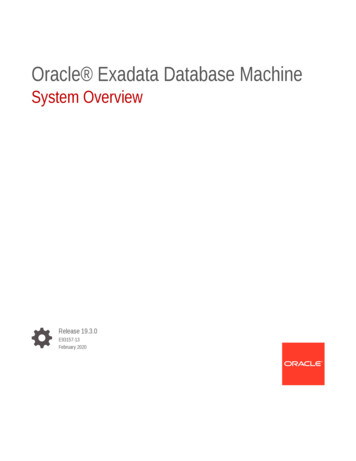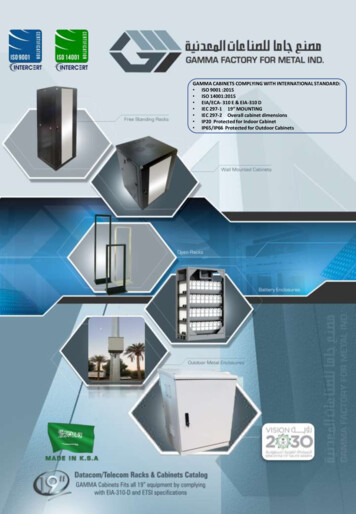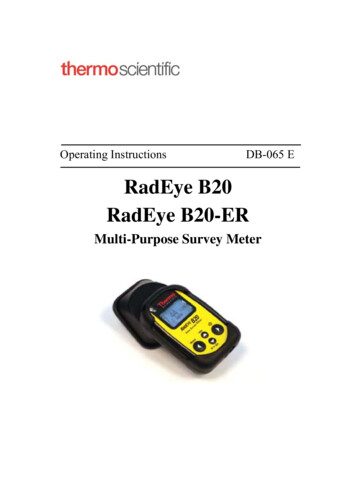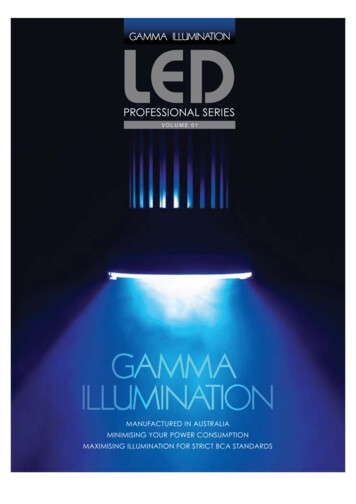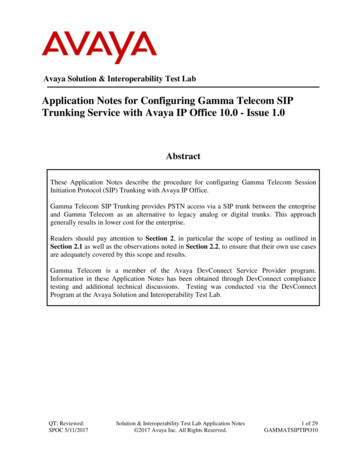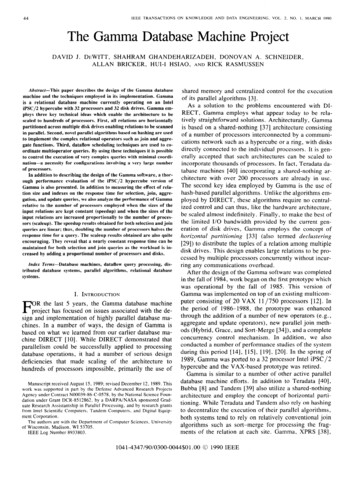
Transcription
IEEE44TRANSACTIONSON KNOWLEDGEANDDATAENGINEERING,VOL.2, NO.1, MARCH1990The Gamma Database Machine ProjectDAVIDJ. DEWITT,ALLANSHAHRAMBRICKER,GHANDEHARIZADEH,HUI-I HSIAO,ANDAbstract-Thispaper describesthe design of the Gammadatabasemachine and the techniquesemployedin its implementation.Gammais a relationaldatabasemachinecurrentlyoperatingon an InteliPSC/2 hypercubewith 32 processorsand 32 disk drives. Gamma employs three key technicalideas which enable the architectureto bescaled to hundredsof processors.First, all relationsare horizontallypartitionedacross multipledisk drives enablingrelations to be scannedin parallel.Second, novel parallel algorithmsbased on hashing are usedto implementthe complexrelationaloperatorssuch as join and aggregate functions.Third,dataflowschedulingtechniquesare used to coordinatemultioperatorqueries. By using these techniquesit is possibleto control the executionof very complexqueries with minimalcoordination-anecessity for configurationsinvolvinga very large numberof processors.In additionto describingthe design of the Gamma software,a thorough performanceevaluationof the iPSC/2hypercubeversionofGamma is also presented.In additionto measuringthe effect of relation size and indexes on the response time for selection,join, aggregation, and update queries, we also analyze the performanceof Gammarelativeto the numberof processorsemployedwhen the sizes of theinput relationsare kept constant(speedup)and when the sizes of theinput relationsare increasedproportionallyto the numberof processors (scaleup).The speedup results obtainedfor both selection and joinqueries are linear; thus, doublingthe numberof processorshalves theresponse time for a query. The scaleup results obtainedare also quiteencouraging.They reveal that a nearly constantresponse time can bemaintainedfor both selection and join queries as the workloadis increased by adding a proportionalnumberof processorsand databasesystems,paralleldataflowquery processing,disalgorithms,relationaldatabaseI. INTRODUCTIONOR the last 5 years, the Gamma database machineproject has focused on issues associated with the design and implementationof highly parallel database machines. In a number of ways, the design of Gamma isbased on what we learned from our earlier database machine DIRECT [lo]. While DIRECT demonstrated thatparallelism could be successfully applied to processingdatabase operations, it had a number of serious designdeficiencies that made scaling of the architecture tohundreds of processors impossible, primarily the use ofFManuscriptreceived August 15, 1989; revised December 12, 1989. Thiswork was supportedin part by the Defense AdvancedResearch ProjectsAgency under Contract N00039-86-C-0578,by the National Science Foundation under Grant DCR-85 12862, by a DARPA/NASAsponsored Graduate Research Assistantshipin Parallel Processing,and by research grantsfrom Intel Scientific Computers,Tandem Computers,and Digital Equipment Corporation.The authors are with the Departmentof ComputerSciences, Universityof Wisconsin,Madison,WI 53705.IEEE Log Number 8933803.104 1-4347/90/0300-0044 0RICKDONOVANA. SCHNEIDER,RASMUSSENshared memory and centralized control for the executionof its parallel algorithms [3].As a solution to the problems encountered with DIRECT, Gamma employs what appear today to be relatively straightforward solutions. Architecturally,Gammais based on a shared-nothing [37] architecture consistingof a number of processors interconnected by a communications network such as a hypercube or a ring, with disksdirectly connected to the individual processors. It is generally accepted that such architectures can be scaled toincorporate thousands of processors. In fact, Teradata database machines [40] incorporating a shared-nothing architecture with over 200 processors are already in use.The second key idea employed by Gamma is the use ofhash-based parallel algorithms. Unlike the algorithms employed by DIRECT, these algorithms require no centralized control and can thus, like the hardware architecture,be scaled almost indefinitely. Finally, to make the best ofthe limited I/O bandwidth provided by the current generation of disk drives, Gamma employs the concept ofhorizontal partitioning[33] (also termed declustering[29]) to distribute the tuples of a relation among multipledisk drives. This design enables large relations to be processed by multiple processors concurrently without incurring any communicationsoverhead.After the design of the Gamma software was completedin the fall of 1984, work began on the first prototype whichwas operational by the fall of 1985. This version ofGamma was implemented on top of an existing multicomputer consisting of 20 VAX 11/750 processors [ 121. Inthe period of 1986- 1988, the prototype was enhancedthrough the addition of a number of new operators (e.g.,aggregate and update operators), new parallel join methods (Hybrid, Grace, and Sort-Merge [34]), and a completeconcurrency control mechanism. In addition, we alsoconducted a number of performance studies of the systemduring this period [ 141, [ 151, [ 191, [20]. In the spring of1989, Gamma was ported to a 32 processor Intel iPSC /2hypercube and the VAX-based prototype was retired.Gamma is similar to a number of other active paralleldatabase machine efforts. In addition to Teradata [40],Bubba [8] and Tandem [39] also utilize a shared-nothingarchitecture and employ the concept of horizontal partitioning. While Teradata and Tandem also rely on hashingto decentralize the execution of their parallel algorithms,both systems tend to rely on relatively conventional joinalgorithms such as sort-merge for processing the fragments of the relation at each site. Gamma, XPRS [38],1.OO 0 1990 IEEE
DeWITTet al.:THEGAMMADATABASEMACHINE45PROJECTand Volcano 1221 each utilize parallel versions of the Hybrid join algorithm [ 1 I].The remainder of this paper is organized as follows. InSection II, we describe the hardware used by each of theGamma prototypes and our experiences with each. Section III discusses the organization of the Gamma softwareand describes how multioperatorqueries are controlled.The parallel algorithms employed by Gamma are described in Section IV and the techniques we employ fortransaction and failure management are contained in Section V. Section VI contains a performance study of the 32processor Intel hypercube prototype. Our conclusions andfuture research directions are described in Section VII.INTERCONNECTIONNETWORKFig. 1.II. HARDWARE ARCHITECTURE OF GAMMAA. OverviewGamma is based on the concept of a shared- -nothing architecture [37] in which processors do not share d iskdrives or random access memory and can only communicate with one another by sending messages th rough aninterconnection network. Mass storage in such an architecture is generally distributed among the processors byconnecting one or more disk drives to each processor asshown in Fig. 1. There are a number of reasons why theshared-nothing approach has become the architecture ofchoice. First, there is nothing to prevent the architecturefrom scaling to thousands of processors unlike sharedmemory machines for which scaling beyond 30-40 processors may be impossible. Second, as demonstrated in[ 151, [8], and [39], by associating a small number of diskswith each processor and distributing the tuples of eachrelation across the disk drives, it is possible to achievevery high aggregate I/O bandwidths without using custom disk controllers [27], [3 11. Furthermore, by employing off-the-shelf mass storage technology one can employthe latest technology in small 3 l/2 in. disk drives withembedded disk controllers. Another advantage of theshared nothing approach is that there is no longer any needto “t-0 11 your own” hardware . Recen .tly , both Intel andNcube have added mass storage to their hypercube-basedmultiprocessor products.B. Gamma Version 1.0The initial version of Gamma consisted of 17 VAX11/750 processors, each with 2 megabytes of memory.An 80 Mb/s token ring [32] was used to connect the processors to each other and to another VAX running UNIX.This processor acted a S the host machi ne for Gamma. Attached to eight of the Processors were 333 megabyte Fujitsu disk dri ves that were used for stori .ng th e database.The diskless processors were used along with the processors with disks to execute join and aggregate function operators in order to explore whether diskless processorscould be exploited effectively.We encountered a number of problems with this prototype. First, the token ring has a maximum networkpacket size of 2K bytes. In the first version of the prototype, the size of a disk page was set to 2K bytes in orderto be able to transfer an “intact” disk page from one processor to another without a copy. This required, for example, that each disk page also contain space for the protocol header used by the interprocessor communicationsoftware. While this initially appeared to be a good idea,we quickly realized that the benefits of a larger disk pagesize more than offset the cost of having to copy tuplesfrom a disk page into a network packet.The second problem we encountered was that the network interface and the Unibus on the 11/750 were bothbottlenecks [ 181, [ 151. While the bandwidth of the tokenring itself was 80 Mb/s, the Unibus on the 11/750 (towhich the network interface was attached) has a bandwidth of only 4 Mb/s. When processing a join querywithout a selection predicate on either of the input relations, the Unibus became a bottleneck because the transfer rate of pages from the disk was higher than the speedof the Unibus [ 151. The network interface was a bottleneck because it could only buffer two incoming packetsat a time. Until one packet was transferred into the VAX’smemory, other incoming packets were rejected and had tobe retransmitted by the communicationsprotocol. Whilewe eventually constructed an interface to the token ringthat plugged directly into the backplane of the VAX, bythe time the board was ope rational the VAX’s were obsolete and we elected not to spend addit .ional funds to UPgrade the entire system.The other serious problem we encountered with thisprototype was having only 2 megabytes of memory oneach processor. This was especially a problem since theoperating system used by Gamma does not provide vi rtualmemory. The problem was exacerbated by the fact thatspace for join hash tables, stack space for proces ses, andthe bu ffer pool were managed separate1 y in order to avoidflushing hot pages from the buffer pool. While there areadvantages to having these spaces managed separately bYthe software, in a configuration where memory is alreadytight, balancing the sizes of these three pools of memoryproved difficult.C. Gamma Version 2.0In the fall of 1988, we replaced the VAX-based prototype with a 32 processor iPSC /2 hypercube from Intel.
IEEE46TRANSACTIONSEach processor is configured with a 386 CPU, 8 megabytes of memory, and a 330 megabyte MAXTOR4380(5 l/4 in. ) disk drive. Each disk drive has an embeddedSCSI controller which provides a 45 Kbyte RAM bufferthat acts as a disk cache on read operations.The nodes in the hypercube are interconnected to forma hypercube using custom VLSI routing modules. Eachmodule supports eight’ full-duplex, serial, reliable communication channels operating at 2.8 megabytes/s. Smallmessages ( 5 100 bytes) are sent as datagrams. ‘For largemessages, the hardware builds a communicationscircuitbetween the two nodes over which the entire message istransmitted without any software overhead or copying.After the message has been completely transmitted, thecircuit is released. The length of a message is limited onlyby the size of the physical memory on each processor.Table I summarizes the transmission times from oneGamma process to another (on two different hypercubenodes) for a variety of message sizes.The conversion of the Gamma software to the hypercube began in early December 1988. Because most usersof the Intel hypercube tend to run a single process at atime while crunching numerical data, the operating system provided by Intel supports only a limited number ofheavyweight processes. Thus, we began the conversionprocess by porting Gamma’s operating system, NOSE (seeSection III-E). In order to simplify the conversion, weelected to run NOSE as a thread package inside a singleNX/2 process in order to avoid having to port NOSE torun on the bare hardware directly.Once NOSE was running, we began converting theGamma software. This process took 4-6 man months butlasted about 6 months as, in the process of the conversion,we discovered that the interface between the SCSI diskcontroller and memory was not able to transfer disk blockslarger than 1024 bytes (the pitfall of being a beta test site).For the most part, the conversion of the Gamma softwarewas almost trivial as, by porting NOSE first, the differences between the two systems in initiating disk and message transfers were completely hidden from the Gammasoftware. In porting the code to the 386, we did discovera number of hidden bugs in the VAX version of the codeas the VAX does not trap when a null pointer is dereferenced. The biggest problem we encountered was thatnodes on the VAX multicomputerwere numbered beginning with 1 while the hypercube uses 0 as the logical address of the first node. While we thought that making thenecessary changes would be tedious but straightforward,we were about half way through the port before we realized that we would have to find and change every “for”loop in the system in which the loop index was also usedas the address of the machine to which a message was tobe sent. While this sounds silly now, it took us severalweeks to find all the places that had to be changed. Inretrospect, we should have made NOSE mask the differences between the two addressing schemes.‘On configurationstiitheight channels is dedicateda mix of computefor communicationand I/O nodes, one of theto the I/O subsystem.ON KNOWLEDGEANDDATAENGINEERING,TABLEPacket Size (in bytes)50500WOO4ooo8oooVOL.2, NO.I, MARCH1990ITransmissionTime0.74 ms.1.46 ms.1.57 ms.2.69 ms.4.64 ms.From a database system perspective, however, there area number of areas in which Intel could improve the designof the iPSC /2. First, a lightweight process mechanismshould be provided as an alternative to NX /2. While thiswould have almost certainly increased the time requiredto do the port, in the long run we could have avoidedmaintaining NOSE. A much more serious problem withthe current version of the system is that the disk controllerdoes not perform DMA transfers directly into memory.Rather, as a block is read from the disk, the disk controller does a DMA transfer into a 4K byte FIFO. When theFIFO is half full, the CPU is interrupted and the contentsof the FIFO are copied into the appropriate location inmemory. 2 While a block instruction is used for the copyoperation, we have measured that about 10% of the available CPU cycles are being wasted doing the copy operation. In addition, the CPU is interrupted 13 times duringthe transfer of one 8 Kbyte block partially because a SCSIdisk controller is used and partially because of the FIFObetween the disk controller and memory.III. SOFTWARE ARCHITECTURE OF GAMMAIn this section, we present an overview of Gamma’ssoftware architecture and describe the techniques thatGamma employs for executing queries in a dataflow fashion. We begin by describing the alternative storage structures provided by the Gamma software. Next, the overallsystem architecture is described from the top down. Afterdescribing the overall process structure, we illustrate theoperation of the system by describing the interaction ofthe processes during the execution of several differentqueries. A detailed presentation of the techniques used tocontrol the execution of complex queries is presented inSection III-D. This is followed by an example which illustrates the execution of a multioperator query. Finally,we briefly describe WiSS, the storage systemused to provide low-level database services, and NOSE, the underlying operating system.A. Gamma Storage OrganizationsRelations in Gamma are horizontally partitioned [33]across all disk drives in the system. The key idea behindhorizontally partitioning each relation is to enable the database software to exploit all the I/O bandwidth providedby the hardware. By declustering3 the tuples of a relation,*Intel was forced to use such a design because the I/O system was addedafter the system had been completed and the only way of doing I/O was byusing a empty socket on the board which did not have DMA access tomemory.‘Declusteringis another term for horizontalpartitioningthat was coinedby the Bubba project [29].
DeWITTet al.:THEGAMMADATABASEMACHINE47PROJECTthe task of parallelizinga selection/scan operator becomes trivial as all that is required is to start a copy ofthe operator on each processor.The query language of Gamma provides the user withthree alternative declustering strategies: round robin,hashed, and range partitioned. With the first strategy, tuples are distributed in a round-robin fashion among thedisk drives. This is the default strategy and is used for allrelations created as the result of a query. If the hashedpartitioningstrategy is selected, a randomizing functionis applied to the key attribute of each tuple (as specifiedin the partition command for the relation) to select a storage unit. In the third strategy, the user specifies a rangeof key values for each site. For example, with a four disksystem, the command partition employee on emp id ( 100,300, 1000) would result in the distribution of tuples shownin Table II. The partitioning information for each relationis stored in the database catalog. For range and hash-partitioned relations, the name of the partitioning attribute isalso kept and, in the case of range-partitionedrelations,the range of values of the partitioning attribute for eachsite (termed a range table).Once a relation has been partitioned, Gamma providesthe normal collection of relational database system accessmethods including both clustered and nonclustered indexes. When the user requests that an index be created ona relation, the system automatically creates an index oneach fragment of the relation. Unlike VSAM [41] and theTandem file system [ 171, Gamma does not require theclustered index for a relation to be constructed on the partitioning attribute.As a query is being optimized, the partitioning information for each source relation in the query is incorporated into the query plan produced by the query optimizer.In the case of hash and range-partitionedrelations, thispartitioning information is used by the query scheduler(discussed below) to restrict the number of processors involved in the execution of selection queries on the partitioning attribute. For example, if relation X is hash partitioned on attribute y, it is possible to direct selectionoperations with predicates of the form “X. y Constant”to a single site; avoiding the participation of any othersites in the execution of the query. In the case of rangepartitioned relations, the query scheduler can restrict theexecution of the query to only those processors whoseranges overlap the range of the selection predicate (whichmay be either an equality or range predicate).In retrospect, we made a serious mistake in choosing todecluster all relations across all nodes with disks. A muchbetter approach, as proposed in [8], is to use the “heat”of a relation to determine the degree to which the relationis declustered. Unfortunately,to add such a capability tothe Gamma software at this point in time would require afairly major effort-one we are not likely to undertake.B. Gamma Process StructureThe overall structure of the various processes that formthe Gamma software is shown in Fig. 2. The role of eachTABLEIIprocess is described briefly below. The operation of thedistributed deadlock detection and recovery mechanismare presented in Sections V-A and V-B. At system initialization time, a UNIX daemon process for the catalogmanager (CM) is initiated along with a set of schedulerprocesses, a set of operator processes, the deadlock detection process, and the recovery process.Catalog Manager: The function of the catalog manager is to act as a central repository of all conceptual andinternal schema informationfor each database. Theschema information is loaded into memory when a database is first opened. Since multiple users may have thesame database open at once and since each user may reside on a machine other than the one on which the catalogmanager is executing, the catalog manager is responsiblefor ensuring consistency among the copies cached by eachuser.Query Manager: One query manager process is associated with each active Gamma user. The query manageris responsible for caching schema informationlocally,providing an interface for ad-hoc queries using gdl (ourvariant of Quel [37]), query parsing, optimization,andcompilation.Scheduler Processes: While executing, each multisitequery is controlled by a scheduler process. This processis responsible for activating the operator processes usedto execute the nodes of a compiled query tree. Schedulerprocesses can be run on any processor, ensuring that noprocessor becomes a bottleneck. In practice, however,scheduler processes consume almost no resources and itis possible to run a large number of them on a single processor. A centralized dispatching process is used to assignscheduler processes to queries. Those queries that the optimizer can detect to be single-site queries are sent directly to the appropriate node for execution, bypassing thescheduling process.Operator Process: For each operator in a query tree,at least one operator process is employed at each processor participating in the execution of the operator. Theseoperators are primed at system initializationtime in orderto avoid the overhead of starting processes at query execution time (additionalprocesses can be forked asneeded). The structure of an operator process and themapping of relational operators to operator processes isdiscussed in more detail below. When a scheduler wishesto start a new operator on a node, it sends a request to aspecial communicationsport known as the “new task”port. When a request is received on this port, an idle operator process is assigned to the request and the communications port of this operator process is returned to therequesting scheduler process.
RING,VOL.2, NO.I, MARCH1990MANAGERMANAGERHOST4* ------------ - -- --------------------GAMMAPROCESSORSFig. 2. GammaC. An Overview of Query ExecutionAd-hoc and Embedded Query Interfaces: Two interfaces to Gamma are available: an ad-hoc query languageand an embedded query language interface in which queries can be embedded in a C program. When a user invokesthe ad-hoc query interface, a query manager (QM) process is started which immediatelyconnects itself to theCM process through the UNIX Internet socket mechanism. When the compiled query interface is used, the preprocessor translates each embedded query into a compiledquery plan which is invoked at run-time by the program.A mechanism for passing parameters from the C programto the compiled query plans at run time is also provided.Query Execution: Gamma uses traditionalrelationaltechniques for query parsing, optimization [36], [26], andcode generation. The optimizationprocess is somewhatsimplified as Gamma only employs hash-based algorithmsfor joins and other complex operations. Queries are compiled into a left-deep tree of operators. At execution time,each operator is executed by one or more operator processes at each participating site.In designing the optimizer for the VAX version ofGamma, the set of possible query plans considered by theoptimizer was restricted to only left-deep trees becausewe felt that there was not enough memory to support rightdeep or bushy plans. By using a combination of left-deepquery trees and hash-based join algorithms, we were ableto ensure that no more than two join operations were everactive simultaneouslyand hence were able to maximizethe amount of physical memory which could be allocatedprocessstructure.to each join operator. Since this memory limitationwasreally only an artifact of the VAX prototype, we have recently begun to examine the performance implications ofright-deep and bushy query plans [35].As discussed in Section III-A, in the process of optimizing a query, the query optimizer recognizes that certain queries can be directed to only a subset of the nodesin the system. In the case of a single site query, the queryis sent directly by the QM to the appropriate processor forexecution. In the case of a multiple site query, the optimizer establishes a connection to an idle scheduler process through a centralized dispatcher process. The dispatcher process, by controllingthe number of activeschedulers, implements a simple load control mechanism.Once it has established a connection with a scheduler process, the QM sends the compiled query to the schedulerprocess and waits for the query to complete execution.The scheduler process, in turn, activates operator processes at each query processor selected to execute the operator. Finally, the QM reads the results of the query andreturns them through the ad-hoc query interface to the useror through the embedded query interface to the programfrom which the query was initiated.D. Operator and Process StructureThe algorithms for all the relational operators are written as if they were to be run on a single processor. Asshown in Fig. 3, the input to an operator process is astream of tuples and the output is a stream of tuples thatis demultiplexed through a structure we term a split table.
DeWITTet STREAMOUTGOINGSTREAMSOF TUPLEShPROCESSOF TUPLESBEXECUTINGSPLIT.*-TABLEOPERATORFig.Once the process begins execution, it continuously readstuples from its input stream, operates on each tuple, anduses a split table to route the resulting tuple to the processindicated in the split table.4 When the process detects theend of its input stream, it first closes the output streamsand then sends a control message to its scheduler processindicating that it has completed execution. Closing theoutput streams has the side effect of sending “end ofstream .’ ’ message s to each of the destin ation proces lses.The split table defines a maPP ing of values to a set ofdestination processes. Gamma uses three different typesof split tables depending on the type of operation beingperformed [ 141. As an example of one form of split table,consider the use of the split table shown in Fig. 4 in conjunction with the execution of a join operation using fourprocessors. Each process producing tuples for the join willapply a hash function to the join attribute of each outputtuple to produce a value between 0 and 3. This value isthen used as an index into the split table to obtain theaddress of the destination process that should receive thetuple.An Example: As an example of how queries are executed, consider the query shown in Fig. 5. In Fig. 6, theprocesses used to execute the query are shown along withthe flow of data between the various processes for aGamma configuration consisting of two processors withdisks and two processors without disks. Since the two input relations A and B are partitioned across the disks attached to processors PI and P2, selection and scan operators are initiated on both processors Pl and P2. The splittables for both the select and scan operators each containtwo entries since two processors are being used for thejoin operation. The split tables for each selection and scanare identical-routingtuples whose join attribute valueshash to 0 (dashed lines) to P3 and those which hash to 1(solid lines) to P4. The join operator executes in twophases. During the first phase, termed the building phase,tuples from the inner relation (A in this example) are inserted into a memory-residenthash table by hashing onthe join attribute value. After the first phase has completed, the probing phase of the join is initiated in which“Tuplesare actuallysent as 8K byte batches,exceptfor the last batch.3.ValueDestinationProcess(Processor #3, Port #5)(Processor #2, Port # 13)(Processor #7, Port #6)(Processor #9, Port #15)Fig. 4. An exampleTAsplit tableTBFig. 5.tuples from the outer relation are used to probe the hashtable for matching tuples? Since the result relation is partitioned across two disks, the split table for each join operator contains two entries and tuples of C are distributedin a round-robin fashion among PI and P2.One of the main problems with the DIRECT prototypewas that every data page processed required at least onecontrol message to a centralized scheduler. In Gamma,this bottleneck is completely avoided. In fact, the numberof control messages required to execute a query is approximately equal to three times the number of operatorsin the query times the number of processors used to execute each operator. As an example, consider Fig. 7 whichdepicts the flow of control messages6 from a schedulerprocess to the processes on processors PI and P3 in Fig.6 (an identical set of messages would flow from the sched‘This is actually a descriptionof the simple hash join algorithm.Theoperation of the hybrid hash join algorithmis contained in Section IV.6The “Initiate”message is sent to a “new operator”port on each processor. A dispatchingprocess accepts incoming messages on this port andassigns the operator to a process. The process, which is assigned, repliesto the scheduler with an “ID”message which indicates the private portnumber of the operator process. Future communicationsto the operatorbythe scheduler use this private port number.
r50IEEETRANSACTIONSO
Gamma, XPRS [38], 104 1-4347/90/0300-0044 0 1 .OO 0 1990 IEEE . DeWITT et al.: THE GAMMA DATABASE MACHINE PROJECT 45 and Volcano 1221 each utilize parallel versions of the Hy- brid join algorithm [ 1 I]. The remainder of this paper is organized as follows. In Section II, we describe the hardware used by each of the .



